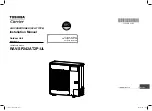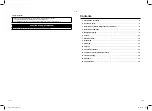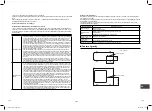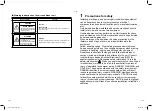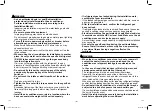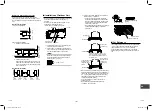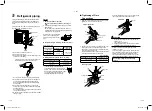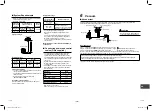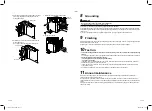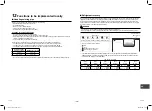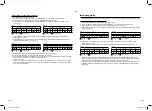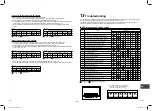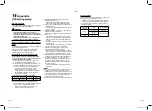
– 11 –
■
Evacuation
CAUTION
UNIT DAMAGE HAZARD
Failure to follow this caution may result in equipment
damage or improper operation.
Never use the system compressor as a vacuum
pump.
Refrigerant tubes and indoor heat exchanger should
be evacuated using the recommended deep vacuum
method of 500 microns. The alternate triple evacuation
method may be used if the procedure outlined below is
followed. Always break a vacuum with dry nitrogen.
■
System Vacuum and Charge
Using Vacuum Pump
1. Completely tighten flare nuts A, B, C, D, connect
manifold gage charge hose to a charge port of the
low side service valve.
Service Valve
C
D
A
B
Outdoor Unit
Refrigerant
Low Side
Service Valve
High Side
Indoor Unit
2. Connect charge hose to vacuum pump.
3. Fully open the low side of manifold gage.
Manifold
Manifold Gage
High side valve
Charge hose
Vacuum pump
Low side valve
Charge hose
Low side valve
500 microns
4. Start vacuum pump.
5. Evacuate using either deep vacuum or triple
evacuation method.
6. After evacuation is complete, fully close the low
side of manifold gage and stop operation of vacuum
pump.
Deep Vacuum Method
The deep vacuum method requires a vacuum pump
capable of pulling a vacuum of 500 microns and a
vacuum gage capable of accurately measuring this
vacuum depth. The deep vacuum method is the most
positive way of assuring a system is free of air and
liquid water.
Deep Vacuum Graph
500
0
1000
1500
2000
2500
3000
3500
4000
4500
5000
1
2
3
4
5
6
7
MICRONS
LEAK IN
SYSTEM
VACUUM TIGHT
TOO WET
TIGHT DRY
SYSTEM
MINUTES
Triple Evacuation Method
The triple evacuation method should only be used
when vacuum pump is only capable of pumping down
to 28 in. of mercury vacuum and system does not
contain any liquid water.
Refer to “Triple Evacuation Method chart” and proceed
as follows:
1. Pump system down to 28 in. of mercury and allow
pump to continue operating for an additional 15
minutes.
2. Close service valves and shut off vacuum pump.
3. Connect a nitrogen cylinder and regulator to system
and open until system pressure is 2 psig.
4. Close service valve and allow system to stand for
1 hr. During this time, dry nitrogen will be able to
diffuse throughout the system absorbing moisture.
5. Repeat this procedure as indicated in the chart.
System will then be free of any cotaminants and
water vapor.
Triple Evacuation Method chart
EVACUATE
BREAK VACUUM WITH DRY NITROGEN
WAIT
EVACUATE
BREAK VACUUM WITH DRY NITROGEN
WAIT
EVACUATE
CHECK FOR TIGHT, DRY SYSTEM
(IF IT HOLDS DEEP VACCUM)
RELEASE CHARGE INTO SYSTEM
■
Final Tubing Check
IMPORTANT:
Check to be certain factory tubing on both indoor and
outdoor unit has not shifted during shipment. Ensure
tubes are not rubbing against each other or any sheet
metal. Pay close attention to feeder rubes, making
sure wire ties on feeder tubes are secure and tight.
■
Pump down process
1. Turn off the Air Conditioner system.
2. Connect the charge hose from the manifold valve to
the service port of the packed valve at gas side.
3. Turn on the Air Conditioner system in cooling
operation more than 10 minutes.
4. Check the operating pressure of the system should
be normal value.
(Ref. with product specification)
5. Release the valve rod cap of both service valves.
6. Use the Hexagon wrench to turning the valve rod of
Liquid side fully close.
(*Make sure no entering air into the system)
7. Continue operate Air Conditioner system until and
the gauge of manifold dropped into the range of
0.5 - 0 kgf/cm
2
8. Use the Hexagon wrench to turning the valve rod of
Gas side fully close.
And turn off the Air Conditioner system immediately
thereafter.
9. Remove the gauge manifold from the service port of
the packed valve.
10. Securely tighten the valve rod cap to the both
service valves.
CAUTION
Should be check the compressor operating
condition while pumping down process. It must
not any abnormal sound, more vibration. It is
abnormal condition appears and must turn off the
Air Conditioner immediately.
Open service valves
Open or close the valve.
▼
Liquid side
Open the valve with a
0.16” (4 mm)
hexagon wrench.
▼
Gas side
Valve unit
Using a straight blade
screwdriver, turn it 90°
counter clockwise until
the valve is fully open
(against the stop).
Charge ori
fi
ce
Flare nut
Handle position
Fully closed
Fully opened
Stop pin
Main stopper
•
While the valve is fully opened, after the screwdriver
has reached the stopper, do not apply torque
exceeding 4 ft•lbs (5 N•m). Applying excessive
torque may damage the valve.
Valve handling precautions
•
Open the valve stem until it reaches the stop.
It is unnecessary to apply further force.
•
Securely tighten the cap with a torque wrench.
•
Cap tightening torque
Valve size
Ø3/8” (9.5 mm)
24 - 31 ft•lbs (33 - 42 N•m)
Ø5/8” (15.9 mm)
15 - 18 ft•lbs (20 - 25 N•m)
Charge port
10 - 13 ft•lbs (14 - 18 N•m)
21-EN
22-EN
1131601101 EN FR ES.indb 11
1131601101 EN FR ES.indb 11
4/8/2565 BE 10:14
4/8/2565 BE 10:14

